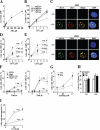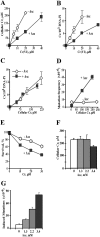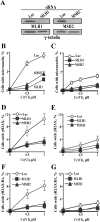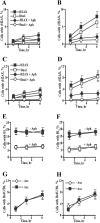Ascorbate acts as a highly potent inducer of chromate mutagenesis and clastogenesis: linkage to DNA breaks in G2 phase by mismatch repair
- PMID: 17169990
- PMCID: PMC1802609
- DOI: 10.1093/nar/gkl1069
Ascorbate acts as a highly potent inducer of chromate mutagenesis and clastogenesis: linkage to DNA breaks in G2 phase by mismatch repair
Abstract
Here we examined the role of cellular vitamin C in genotoxicity of carcinogenic chromium(VI) that requires reduction to induce DNA damage. In the presence of ascorbate (Asc), low 0.2-2 microM doses of Cr(VI) caused 10-15 times more chromosomal breakage in primary human bronchial epithelial cells or lung fibroblasts. DNA double-strand breaks (DSB) were preferentially generated in G2 phase as detected by colocalization of H2AX and 53BP1 foci in cyclin B1-expressing cells. Asc dramatically increased the formation of centromere-negative micronuclei, demonstrating that induced DSB were inefficiently repaired. DSB in G2 cells were caused by aberrant mismatch repair of Cr damage in replicated DNA, as DNA polymerase inhibitor aphidicolin and silencing of MSH2 or MLH1 by shRNA suppressed induction of H2AX and micronuclei. Cr(VI) was also up to 10 times more mutagenic in cells containing Asc. Increasing Asc concentrations generated progressively more mutations and DSB, revealing the genotoxic potential of otherwise nontoxic Cr(VI) doses. Asc amplified genotoxicity of Cr(VI) by altering the spectrum of DNA damage, as total Cr-DNA binding was unchanged and post-Cr loading of Asc exhibited no effects. Collectively, these studies demonstrated that Asc-dependent metabolism is the main source of genotoxic and mutagenic damage in Cr(VI)-exposed cells.
Figures







Similar articles
-
Genotoxicity and mutagenicity of chromium(VI)/ascorbate-generated DNA adducts in human and bacterial cells.Biochemistry. 2003 Feb 4;42(4):1062-70. doi: 10.1021/bi0271547. Biochemistry. 2003. PMID: 12549927
-
WRN helicase promotes repair of DNA double-strand breaks caused by aberrant mismatch repair of chromium-DNA adducts.Cell Cycle. 2009 Sep 1;8(17):2769-78. doi: 10.4161/cc.8.17.9410. Epub 2009 Sep 2. Cell Cycle. 2009. PMID: 19652551 Free PMC article.
-
Cellular vitamin C increases chromate toxicity via a death program requiring mismatch repair but not p53.Carcinogenesis. 2007 Jul;28(7):1613-20. doi: 10.1093/carcin/bgm031. Epub 2007 Feb 14. Carcinogenesis. 2007. PMID: 17301063
-
Complexities of chromium carcinogenesis: role of cellular response, repair and recovery mechanisms.Mutat Res. 2003 Dec 10;533(1-2):3-36. doi: 10.1016/j.mrfmmm.2003.09.006. Mutat Res. 2003. PMID: 14643411 Review.
-
Chromium in drinking water: sources, metabolism, and cancer risks.Chem Res Toxicol. 2011 Oct 17;24(10):1617-29. doi: 10.1021/tx200251t. Epub 2011 Jul 28. Chem Res Toxicol. 2011. PMID: 21766833 Free PMC article. Review.
Cited by
-
Nuclear and Cytoplasmic Functions of Vitamin C.Chem Res Toxicol. 2020 Oct 19;33(10):2515-2526. doi: 10.1021/acs.chemrestox.0c00348. Epub 2020 Oct 1. Chem Res Toxicol. 2020. PMID: 33001635 Free PMC article. Review.
-
Chromium exposure disrupts chromatin architecture upsetting the mechanisms that regulate transcription.Exp Biol Med (Maywood). 2019 Jun;244(9):752-757. doi: 10.1177/1535370219839953. Epub 2019 Apr 1. Exp Biol Med (Maywood). 2019. PMID: 30935235 Free PMC article. Review.
-
Long-term Coexposure to Hexavalent Chromium and B[a]P Causes Tissue-Specific Differential Biological Effects in Liver and Gastrointestinal Tract of Mice.Toxicol Sci. 2015 Jul;146(1):52-64. doi: 10.1093/toxsci/kfv070. Epub 2015 Mar 29. Toxicol Sci. 2015. PMID: 25820237 Free PMC article.
-
Oral Chromium Exposure and Toxicity.Curr Environ Health Rep. 2015 Sep;2(3):295-303. doi: 10.1007/s40572-015-0054-z. Curr Environ Health Rep. 2015. PMID: 26231506 Free PMC article. Review.
-
Prolonged Particulate Hexavalent Chromium Exposure Induces DNA Double-Strand Breaks and Inhibits Homologous Recombination Repair in Primary Rodent Lung Cells.Biol Trace Elem Res. 2024 Dec;202(12):5653-5663. doi: 10.1007/s12011-024-04136-1. Epub 2024 Mar 18. Biol Trace Elem Res. 2024. PMID: 38499919
References
-
- Langard S. One hundred years of chromium and cancer: a review of epidemiological evidence and selected case reports. Am. J. Ind. Med. 1990;17:189–215. - PubMed
-
- Zhitkovich A. Chromium: exposure, toxicity and biomonitoring approaches. In: Wilson S.H., Suk W.A., editors. Biomarkers of Environmentally Associated Disease: Technologies, Concepts, and Perspective. New York: CRC Press LLC; 2002. pp. 269–287.
-
- De Flora S. Threshold mechanisms and site specificity in chromium(VI) carcinogenesis. Carcinogenesis. 2000;21:533–541. - PubMed
Publication types
MeSH terms
Substances
Grants and funding
LinkOut - more resources
Full Text Sources
Medical
Miscellaneous

